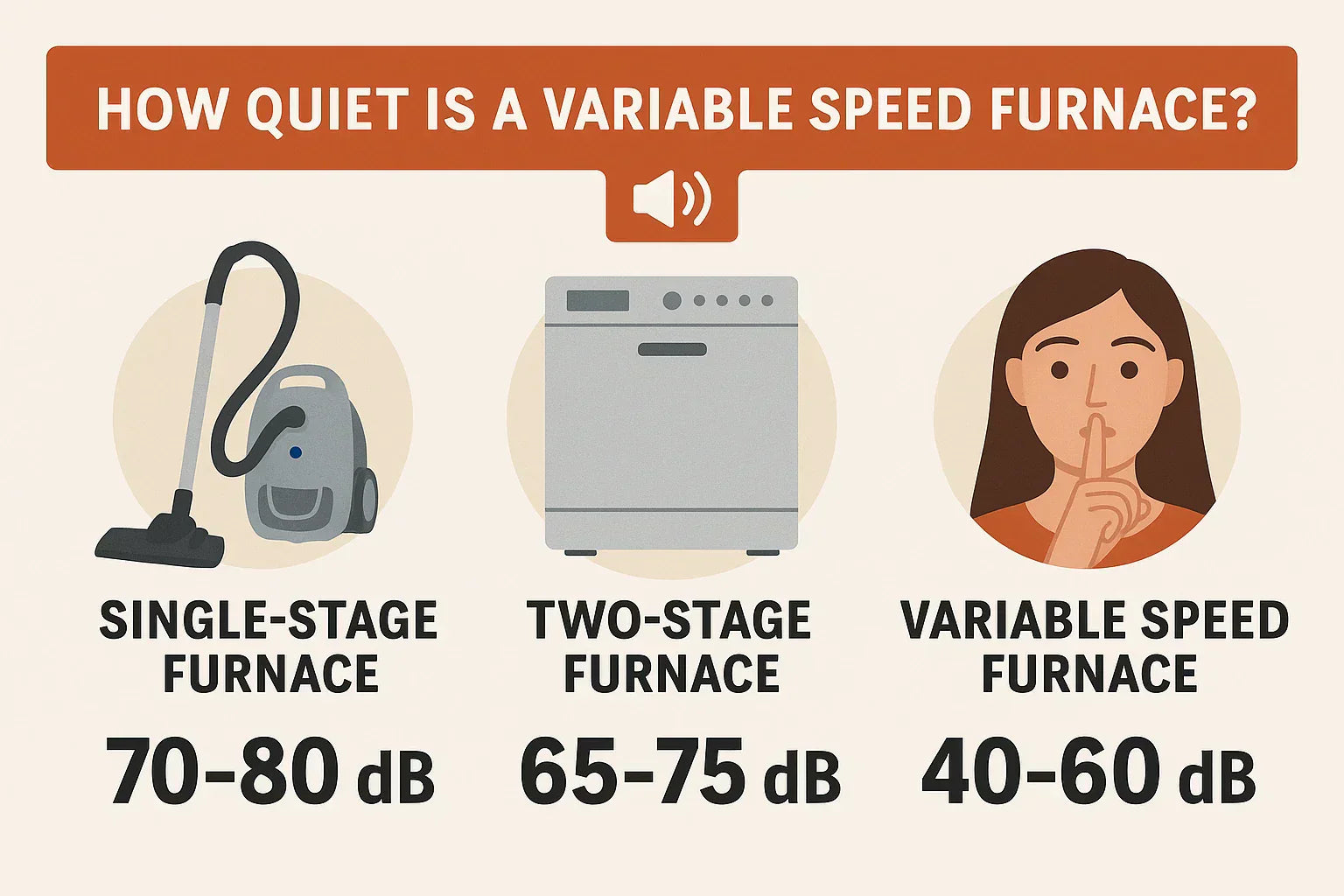👋 Introduction: The Sound of Comfort
If you’ve ever jumped at the sudden whoosh of your furnace firing up, you know that heating systems aren’t always the quietest housemates. Traditional single-stage furnaces run at full blast every time they cycle on, filling your ducts (and sometimes your whole home) with a noticeable roar.
That’s where variable speed furnaces change the game. Designed with electronically commutated motors (ECMs) that can adjust airflow gradually, they deliver consistent warmth without the noise.
But just how quiet are they? And how do they stack up against single-stage and two-stage furnaces? Let’s break it down—Savvy style.
🔊 1. Understanding Furnace Noise
Before we compare models, it helps to know where furnace noise comes from:
-
Blower motor: The fan that pushes air through your ducts. Single-speed blowers = louder.
-
Burners: Gas ignition can cause a “pop” or “boom” if delayed.
-
Metal duct expansion: Air pressure can make ducts flex and “pop.”
-
Cabinet vibration: Poor installation = rattling panels.
👉 Savvy’s Tip: Not all furnace noise comes from the unit itself—sometimes ductwork design amplifies the sound like a drum.
⚙️ 2. What Is a Variable Speed Furnace?
A variable speed furnace uses an ECM motor that adjusts its fan speed continuously, instead of switching between just “on” and “off.”
How It Compares
-
Single-Stage Furnace: One speed. Always full power.
-
Two-Stage Furnace: Two speeds (low and high). Quieter than single-stage, but still noticeable.
-
Variable Speed Furnace: Infinite speeds, automatically adjusting airflow to what’s needed.
The result? Quieter operation, better comfort, and greater efficiency.
📉 3. Noise Levels Compared (Decibels)
Noise is measured in decibels (dB). Here’s how furnace types compare:
| Furnace Type | Typical Noise Level | Everyday Comparison |
|---|---|---|
| Single-Stage | 70–80 dB | Like a vacuum cleaner |
| Two-Stage | 65–75 dB | Like a dishwasher running |
| Variable Speed | 40–60 dB | Like a quiet conversation or background music |
👉 Many homeowners with variable speed furnaces say they barely notice when the system is running.
🌙 4. Why Variable Speed Furnaces Are Quieter
There are several reasons why variable speed = whisper comfort:
-
Gentle Start-Up: Instead of blasting on, the blower ramps up gradually.
-
Continuous Low-Speed Operation: Runs more often, but at lower speeds that produce less noise.
-
ECM Motor Technology: High-efficiency motors vibrate less than traditional PSC motors.
-
Longer, Softer Cycles: Instead of short bursts of hot air, variable furnaces deliver a steady flow.
This makes them especially appreciated at night—no more being jolted awake by a loud furnace cycle.
🏡 5. Comfort Benefits Beyond Noise
A quieter furnace isn’t just about peace of mind—it’s about better comfort overall.
-
Even Temperature Distribution: No more hot blasts followed by cool dips.
-
Improved Humidity Control: Steady airflow helps balance humidity levels.
-
Cleaner Air: Filters work better when air circulates constantly at low speed.
-
Longer Lifespan: Less wear and tear since the motor doesn’t stop/start at full power.
👉 So, while you’re enjoying the quiet, your whole home benefits too.
📊 6. Brand Examples & Noise Reputation
Let’s look at how top furnace brands stack up in terms of noise:
-
Goodman 96 AFUE Variable Speed (GRVT960803BN): Affordable, flexible installation, whisper-quiet ECM motor.
-
Carrier Infinity Series: Premium pricing, known for advanced sound insulation and control.
-
Trane XV Series: Very reliable, moderate-to-premium cost, quieter than single- or two-stage units.
Savvy’s Take:
-
Best Value Quiet Furnace: Goodman (budget-friendly, low noise).
-
Quietest Premium Option: Carrier Infinity (if cost isn’t a concern).
-
Best for Reliability & Comfort: Trane XV Series.
💲 7. Cost vs. Value
Here’s the catch: variable speed furnaces cost more upfront.
Price Comparison (Equipment Only)
-
Single-Stage (80 AFUE): $1,500–$2,500
-
Two-Stage (90–95 AFUE): $2,000–$3,500
-
Variable Speed (96–98 AFUE): $2,500–$5,000+
But consider the long-term value:
-
Lower noise.
-
Reduced monthly gas bills (20–30% savings).
-
Higher resale value (quiet, efficient homes appeal to buyers).
👉 A quieter furnace isn’t just a comfort upgrade—it’s an investment.
🔧 8. Other Tips for a Quieter Furnace System
Even the quietest furnace can get noisy if the system around it isn’t designed well.
-
Proper Installation: Poorly leveled units vibrate more.
-
Duct Design: Undersized ducts = whistling and booming sounds.
-
Insulated Ductwork: Reduces noise transmission.
-
Regular Maintenance: Loose panels or dirty motors make noise worse.
👉 Savvy’s Tip: Don’t overlook your ductwork—sometimes it’s the loudest part of your heating system.
✅ Conclusion: Is a Variable Speed Furnace Worth It for Noise?
Here’s the bottom line:
-
Single-Stage Furnaces: Loud, cheap upfront, but noisy housemates.
-
Two-Stage Furnaces: Quieter, but still noticeable.
-
Variable Speed Furnaces: Whisper quiet, efficient, and comfortable.
If peace, comfort, and long-term value matter to you, a variable speed furnace is worth every penny.
👉 Want a great example? Check out the Goodman 96 AFUE 80,000 BTU Variable Speed Furnace (GRVT960803BN). It’s efficient, affordable, and built for quiet comfort.
In the next topic we will know more about: Maintenance Tips for Your Goodman 96 AFUE Furnace: Filters, Vents & Seasonal Care







